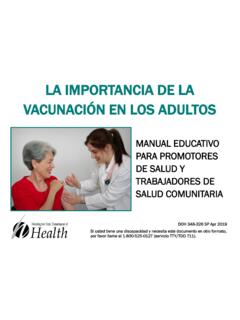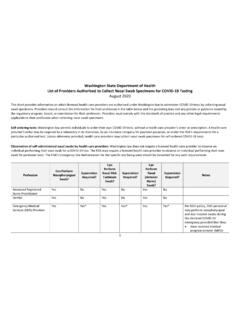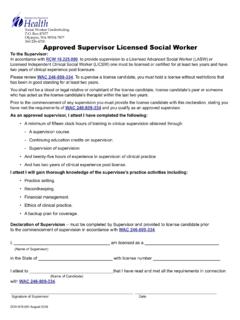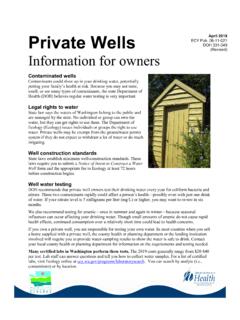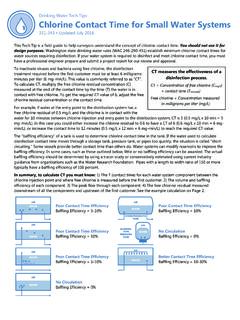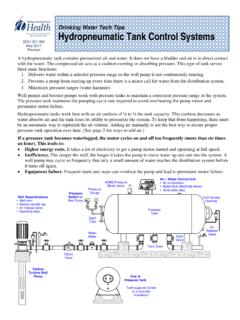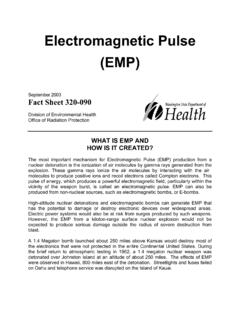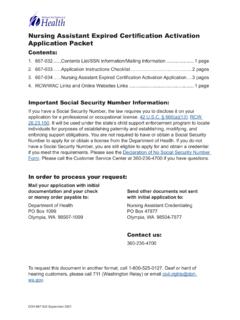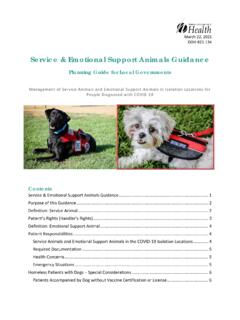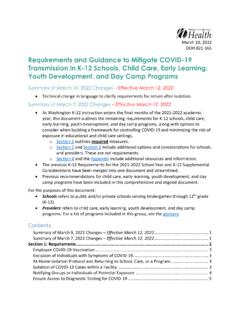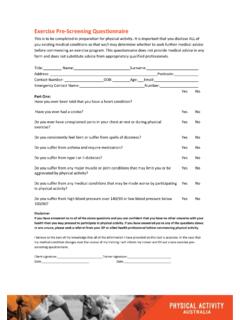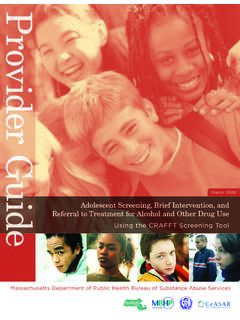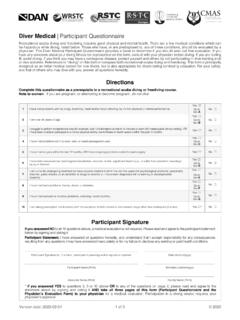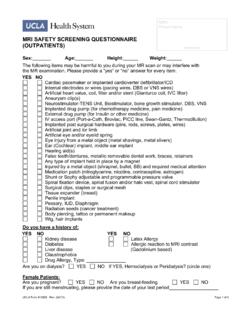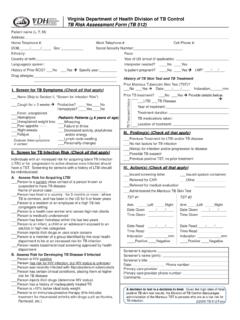Transcription of Guidance for Daily COVID-19 Symptom Screening of Staff …
1 Updated May 18, 2021 DOH 420-306 Guidance for Daily COVID-19 Symptom Screening of Staff and Guests Summary of May 18, 2021 Changes Updated information for fully vaccinated individuals to align with CDC recommendations. Introduction The Washington State Department of Health recommends employers use this Guidance to screen Staff and guests (but not customers in retail) at the start of each shift or visit to prevent the spread of COVID-19 . What is Symptom Screening ? Infection prevention in the workplace is important to prevent the spread of COVID-19 . Screening is one way employers can lower the chance of COVID-19 transmission.
2 Screening will not identify people not yet showing symptoms, or who may be infected but show no symptoms. Who should be screened? Screen Staff and guests who enter the workplace. This does not include customers who are in a public-facing area (for example, customers at a restaurant or supermarket). When should a business screen Staff and guests? Screen Staff and guests at the start of every shift or visit. How should a business set up Symptom Screening ? If you plan in-person health checks, do them safely and respectfully. Employers may use physical distancing, barriers or walls, or personal protective equipment (PPE) to protect the screener.
3 Using PPE alone is not as good as using physical distancing, and users need to be trained how to use PPE. Please refer to Guidance from the Department of Labor & Industries Which Mask for Which Task document to determine the appropriate level of PPE. Give Screening information in languages that Staff and guests understand. Additional information can be found on the Department of Health s Resources and Recommendations page. Do health checks in a way that helps keep people from crowding, such as offering more than one Screening entrance into the building. 2 To prevent stigma and discrimination, make Staff health screenings as private as possible.
4 Do not judge Staff or guests based on race or country of origin. Keep medical status and history safe from others. Follow Guidance from the Equal Employment Opportunity Commission for safekeeping of medical records from health checks. Keep a record of Daily Symptom Screening results for at least 28 days. Follow the directions below on How to screen for COVID-19 . A additional Screening tool example is available here: How to screen for COVID-19 Ask the following questions. 1. Do you have any of these symptoms that are not caused by another condition? Fever or chills Cough Shortness of breath or difficulty breathing Fatigue Muscle or body aches Headache Recent loss of taste or smell Sore throat Congestion Nausea or vomiting Diarrhea 2.
5 If you are not fully vaccinated, have you been in close contact with anyone with COVID-19 in the past 14 days? Close contact is being within 6 feet for 15 minutes or more over a 24-hour period with a person; or having direct contact with fluids from a person with COVID-19 with or without wearing a mask ( , being coughed or sneezed on). 3. Have you had a positive COVID-19 test for active virus in the past 10 days, or are you awaiting results of a COVID-19 test? 4. Within the past 14 days, has a public health or medical professional told you to self-monitor, self-isolate, or self-quarantine because of concerns about COVID-19 infection?
6 What s the difference between isolation and quarantine? Isolation is what you do if you have COVID-19 symptoms, are awaiting test results, or have tested positive. Isolation means you stay home and away from others (including household members) for the recommended period of time to avoid spreading illness. Quarantine is what you do if you have been exposed to COVID-19 . Quarantine means you stay home and away from others for the recommended period of time in case you are infected and are contagious. Quarantine becomes isolation if you later test positive for COVID-19 or develop symptoms.
7 3 What should a business do if Staff answer yes to these questions? *Bringing exposed critical infrastructure or essential workers who are not experiencing any symptoms and have not tested positive back into onsite operations should be used as a last resort and only in limited circumstances, such as when cessation of operation of a facility may cause serious harm or danger to public health or safety. See this Guidance from the CDC and contact your local health department for more information. **If somebody does not have a doctor or health care provider: many locations have free or low-cost testing, regardless of immigration status.
8 See the Department of Health s Testing FAQ or call the WA State COVID-19 Information Hotline. Quarantine for Fully Vaccinated Persons Fully vaccinated persons with an exposure to someone with COVID-19 are not required to quarantine if they meet all of the following criteria: Are fully vaccinated (see When You ve Been Fully Vaccination section below for more information.) Have not had symptoms since current COVID-19 exposure. Do you have any COVID-19 symptoms that are not caused by another condition? If you are not fully vaccinated, have you been in close contact with anyone with COVID-19 in the past 14 days?
9 Have you had a positive COVID-19 test for active virus in the past 10 days, or are you awaiting results of a COVID-19 test? Within the past 14 days, has a public health or medical professional told you to isolate or quarantine due to concerns about COVID-19 infection? YES YES YES YES Don t let them enter the workplace. Immediately separate them from other people and arrange a ride home or to a medical facility, if needed. Tell Staff to isolate at home or another site away from others. Have them call their health care provider** for further instructions, including information about COVID-19 testing.
10 Tell Staff to quarantine at home or another site away from others*. Testing is strongly recommended. If exposure date is known, test no sooner than 72 hours after exposure. If already tested, test again if symptoms develop. Follow the Guidance in What to do if you were potentially exposed to someone with COVID-19 . Tell Staff to isolate at home or another site away from others. Follow Guidance in What to do if you have confirmed or suspected COVID-19 . Tell Staff to follow the instructions provided by the public health or medical professional. Continue isolation or quarantine as directed.
